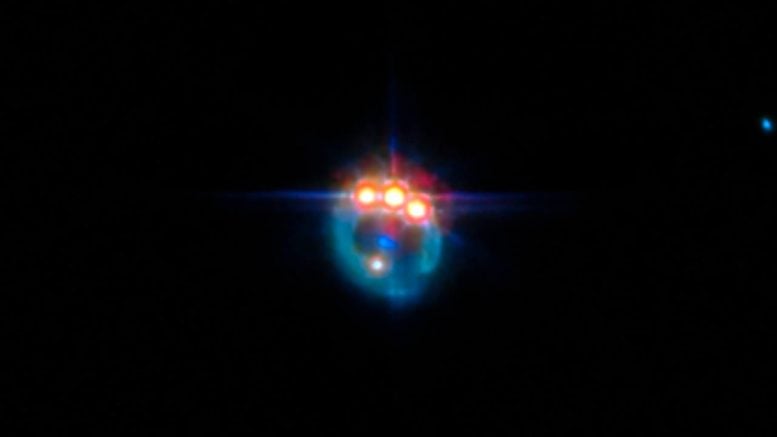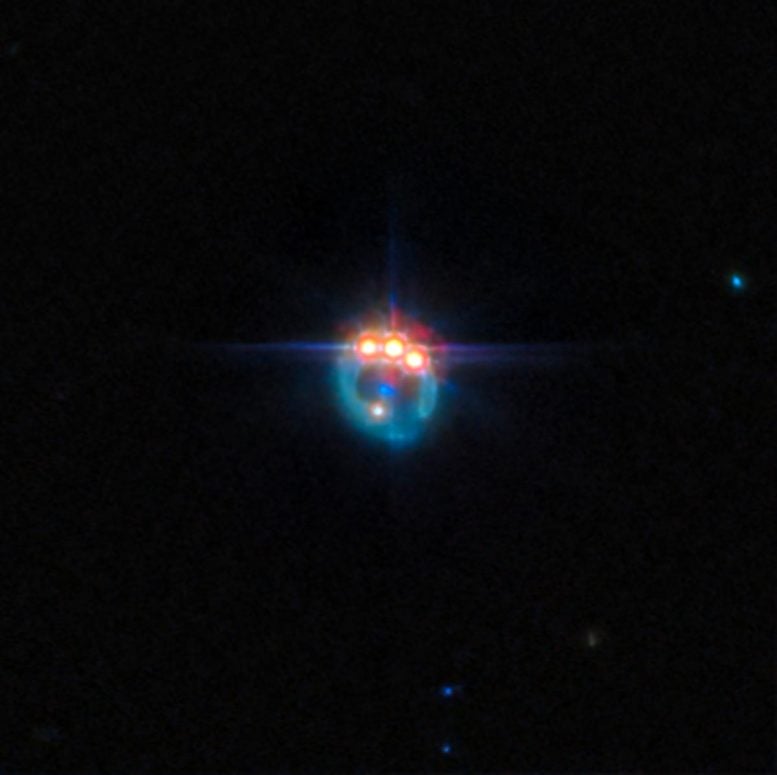
Posted on 07/10/2024 5:26:27 AM PDT by Red Badger

This James Webb Space Telescope image of quasar RX J1131-1231 highlights gravitational lensing, magnifying the quasar to allow detailed study of its properties and the surrounding dark matter. X-ray emissions suggest the black hole is rapidly spinning, likely due to galaxy mergers. Credit: ESA/Webb, NASA & CSA, A. Nierenberg
Webb’s image of RX J1131-1231 uses gravitational lensing to explore the quasar’s black hole and dark matter, revealing details about its growth and the universe’s mass composition.
This new James Webb Space Telescope image features the gravitational lensing of the quasar known as RX J1131-1231, located roughly six billion light-years from Earth in the constellation Crater. It is considered one of the best-lensed quasars discovered to date, as the foreground galaxy smears the image of the background quasar into a bright arc and creates four images of the object.
Gravitational lensing, first predicted by Einstein, offers a rare opportunity to study regions close to the black hole in distant quasars, by acting as a natural telescope and magnifying the light from these sources. All matter in the Universe warps the space around itself, with larger masses producing a stronger effect. Around very massive objects, such as galaxies, light that passes close by follows this warped space, appearing to bend away from its original path by a clearly visible amount. One of the consequences of gravitational lensing is that it can magnify distant astronomical objects, letting astronomers study objects that would otherwise be too faint or far away.

The James Webb Space Telescope has captured an image of the quasar RX J1131-1231, which is located six billion light-years away and demonstrates the effects of gravitational lensing, magnifying the distant quasar into a bright arc and multiple images. Credit: ESA/Webb, NASA & CSA, A. Nierenberg
Measurements of the X-ray emission from quasars can provide an indication of how fast the central black hole is spinning and this gives researchers important clues about how black holes grow over time. For example, if a black hole grows primarily from collisions and mergers between galaxies, it should accumulate material in a stable disc, and the steady supply of new material from the disc should lead to a rapidly spinning black hole. On the other hand, if the black hole grew through many small accretion episodes, it would accumulate material from random directions. Observations have indicated that the black hole in this particular quasar is spinning at over half the speed of light, which suggests that this black hole has grown via mergers, rather than pulling material in from different directions.
VIDEO AT LINK..................
This image was captured with Webb’s MIRI (Mid-Infrared Instrument) as part of an observation program to study dark matter. Dark matter is an invisible form of matter that accounts for most of the Universe’s mass. Webb’s observations of quasars are allowing astronomers to probe the nature of dark matter at smaller scales than ever before.
Webb Ping!......................
When I was little, my Dad had a set of brass knuckles. It kinda looks like those.
Amazing imagery.

The article should mention that "dark matter" is one theory to account for anomalies which have been found that contradict the "big bang" theory of cosmology. There are other, competing theories, such as the speed of light varying with time, as I recall.
Why is she wearing a mop on her head?........................
'Dark Matter' is just a placeholder for something they have no idea about.................
'Dark Matter' is just a placeholder for something they have no idea about.................
Love these Webb Telescope pics.
It’s their ‘out’ for stubborn orthodoxy when revelations eventually prove them all wrong.
</chuckle>
Yes, but they sound so sure about it. You never hear any of these issues unless you are able to see some of the arguments they make amongst themselves.
Disclaimer: Opinions posted on Free Republic are those of the individual posters and do not necessarily represent the opinion of Free Republic or its management. All materials posted herein are protected by copyright law and the exemption for fair use of copyrighted works.